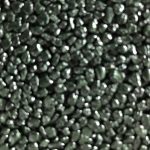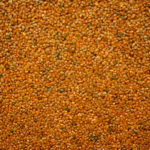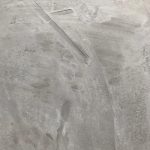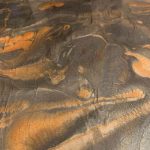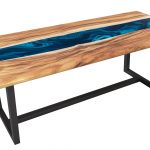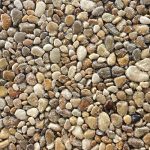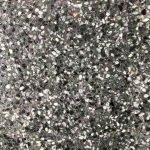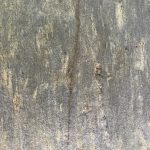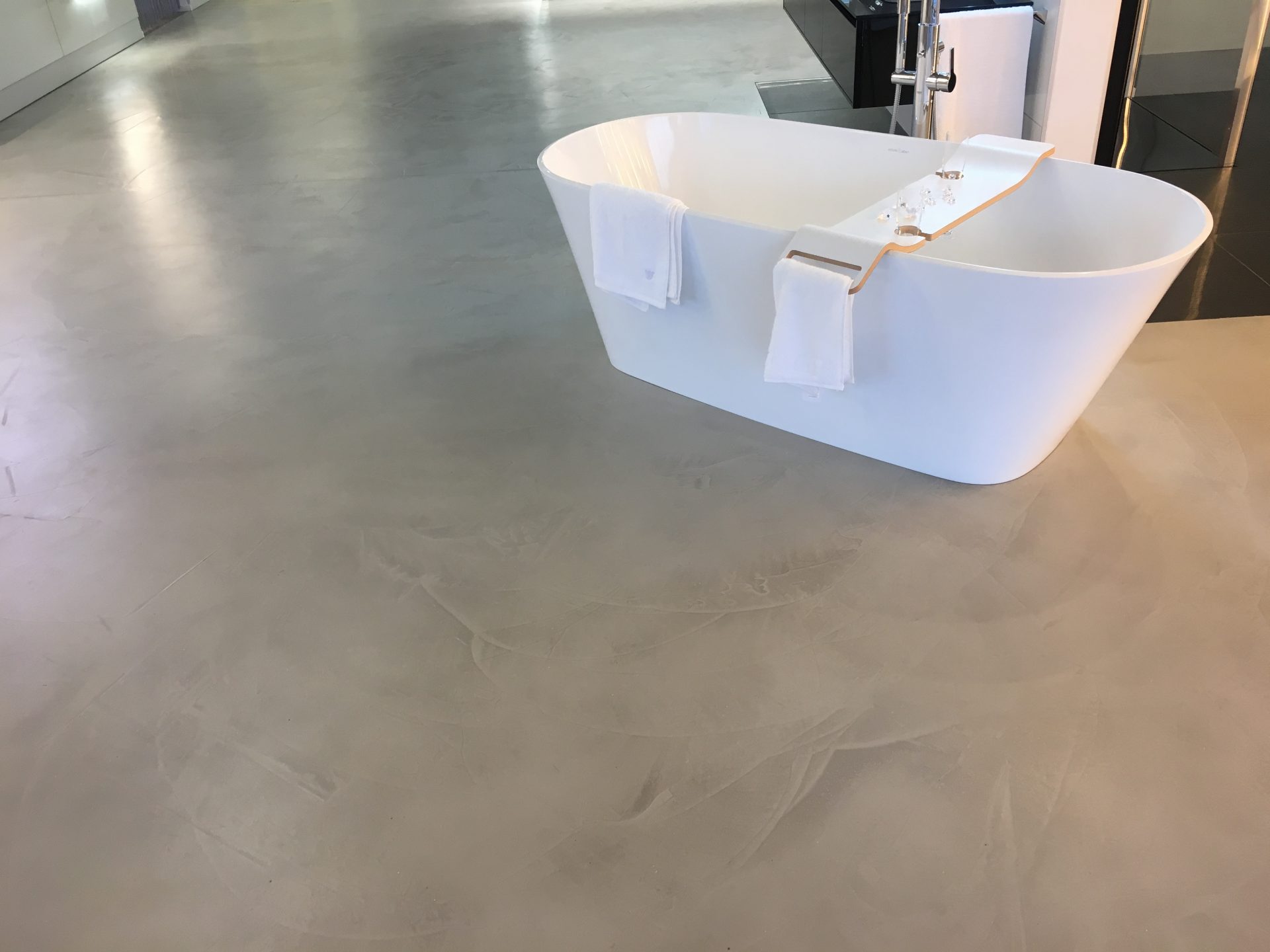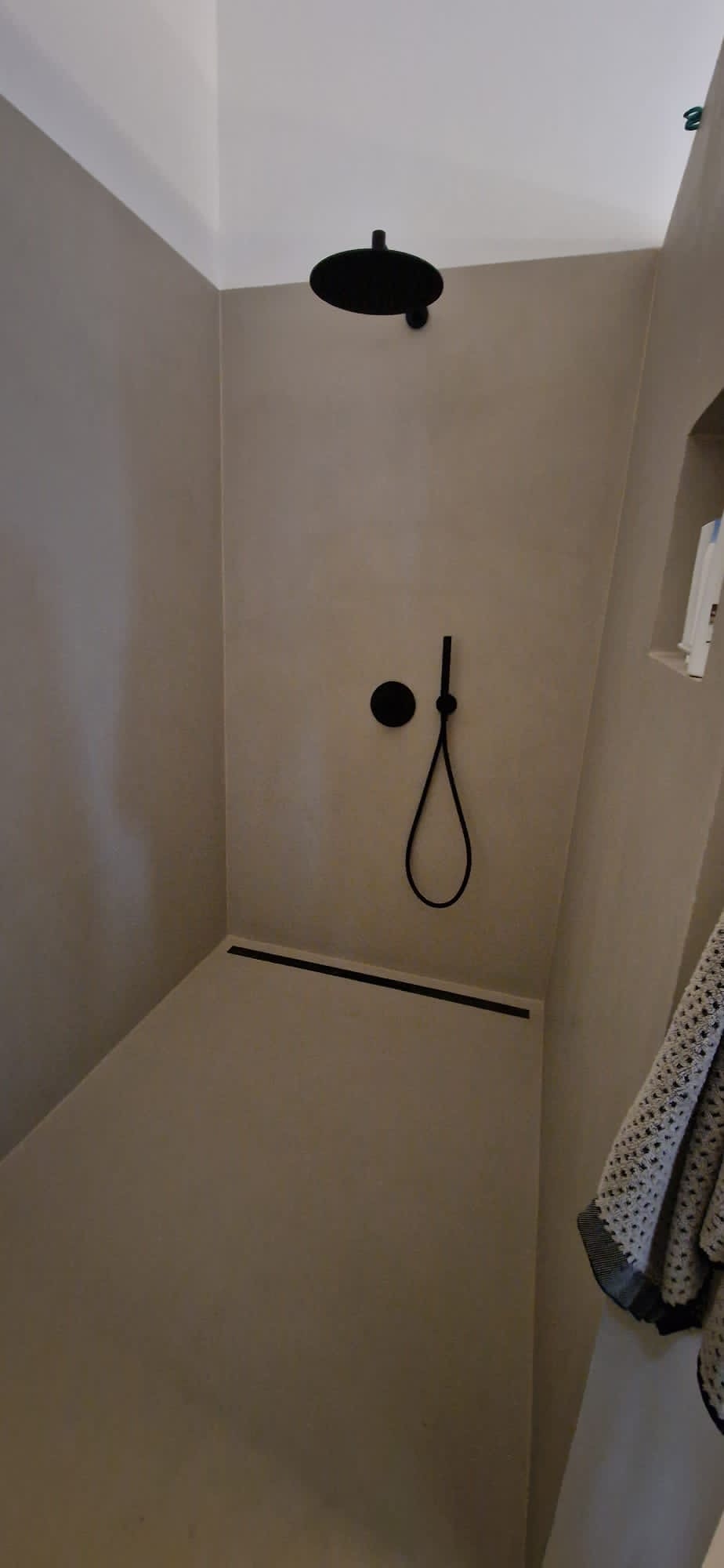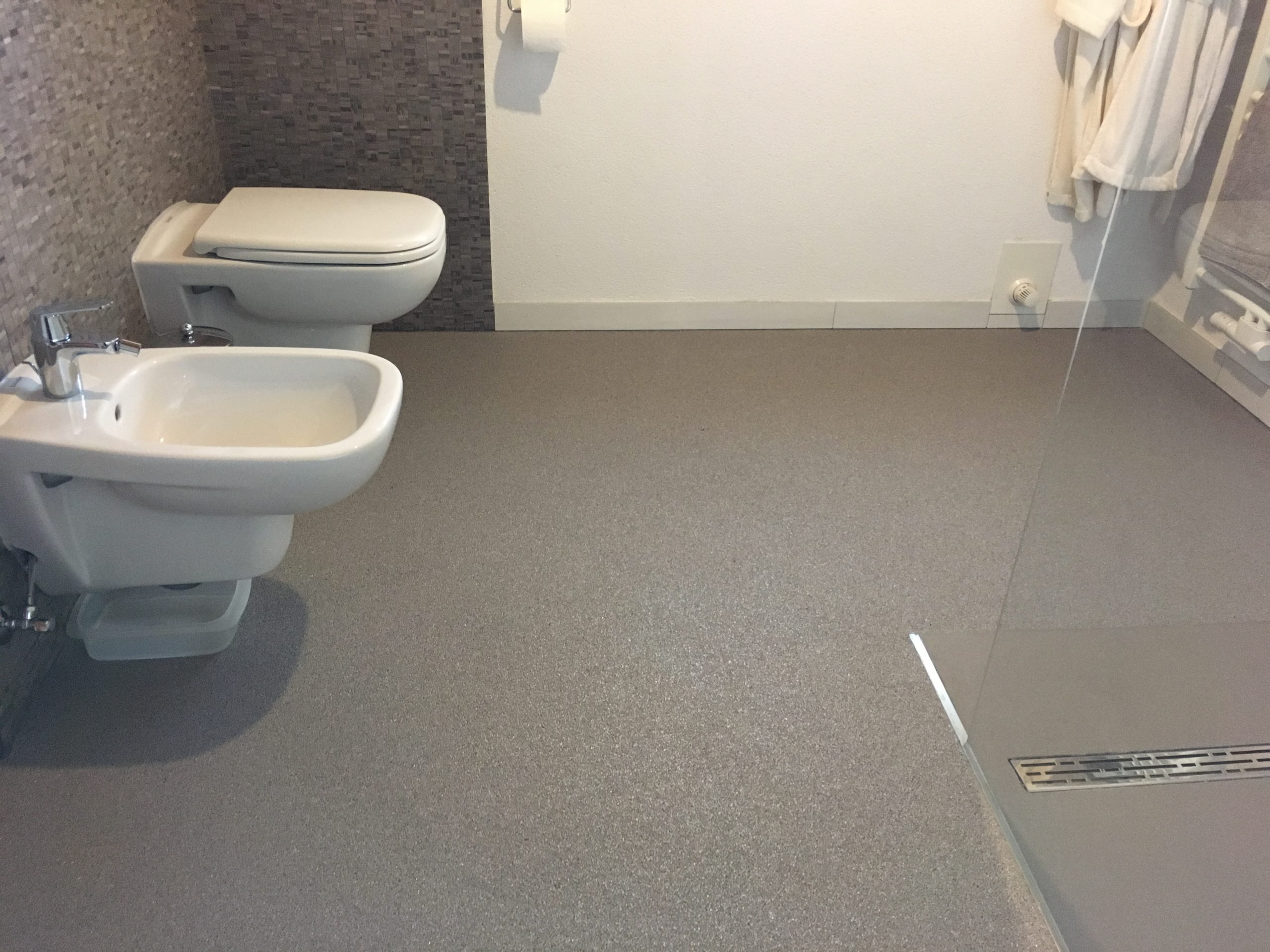Stone carpet is the perfect solution for indoor and outdoor stair renovation. After all, crumbling steps at the entrance to your home don’t look particularly inviting. The Quarzkiesboden Zimmermann team will be happy to advise you on how to renovate, refurbish or recoat stairs with stone carpeting.
Contents
- Renovating interior & exterior stairs with stone carpeting
- Renovating stairs with stone carpet
- Renovating stairs with stone carpet
- Visually enhance wooden stairs with stone carpeting
- From the basement to the attic – these are the advantages of stone carpet stairs
- Renovate stairs with stone carpet in 6 simple steps
- How long does it take to renovate a stone carpet staircase?
- How much does it cost to renovate a stone carpet staircase?
- Non-binding Cost estimate
- Link collection
- FAQ
- Shop
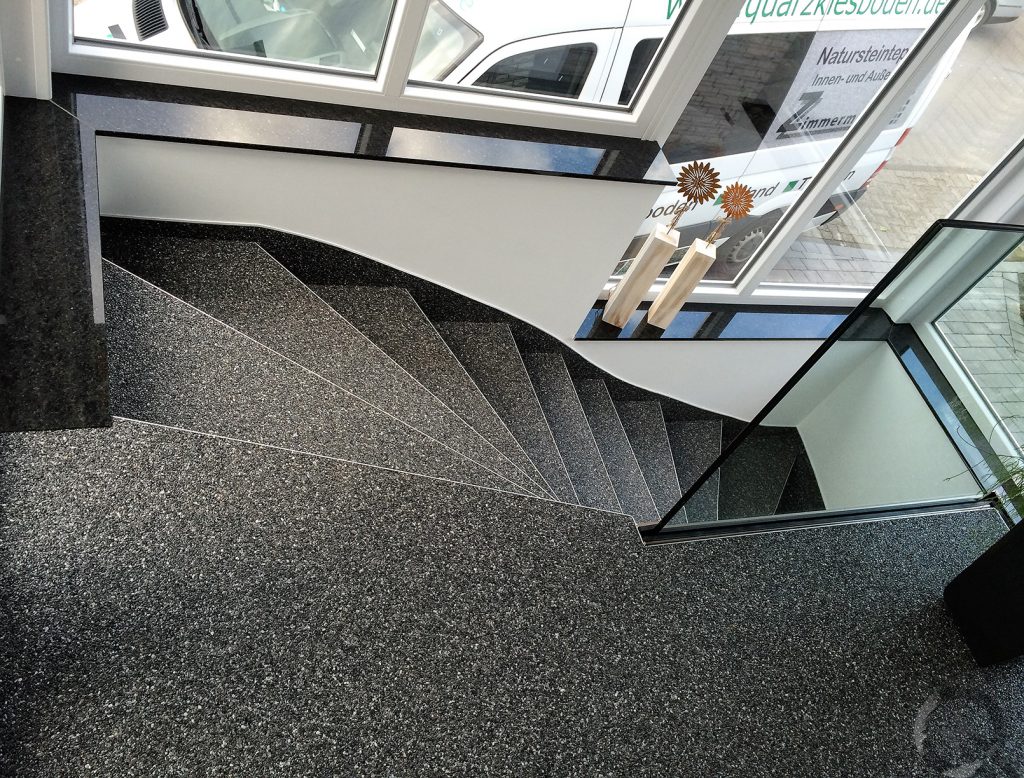
Renovating interior & exterior stairs with stone carpeting
Put an end to old steps and worn edges with stone carpeting!
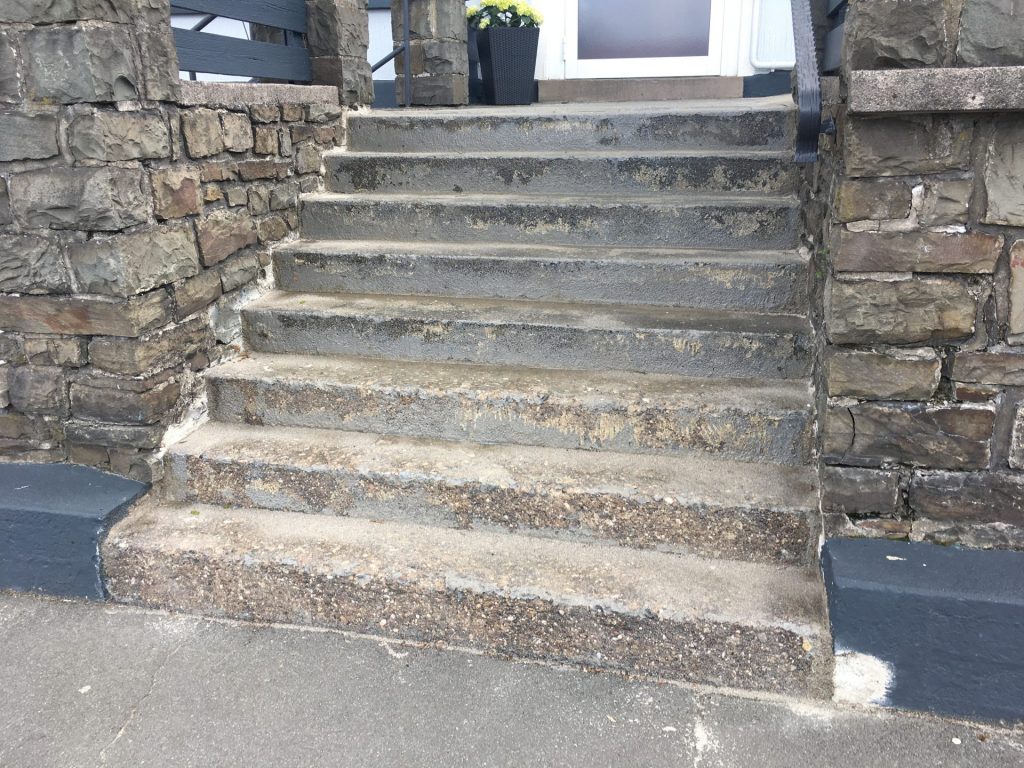
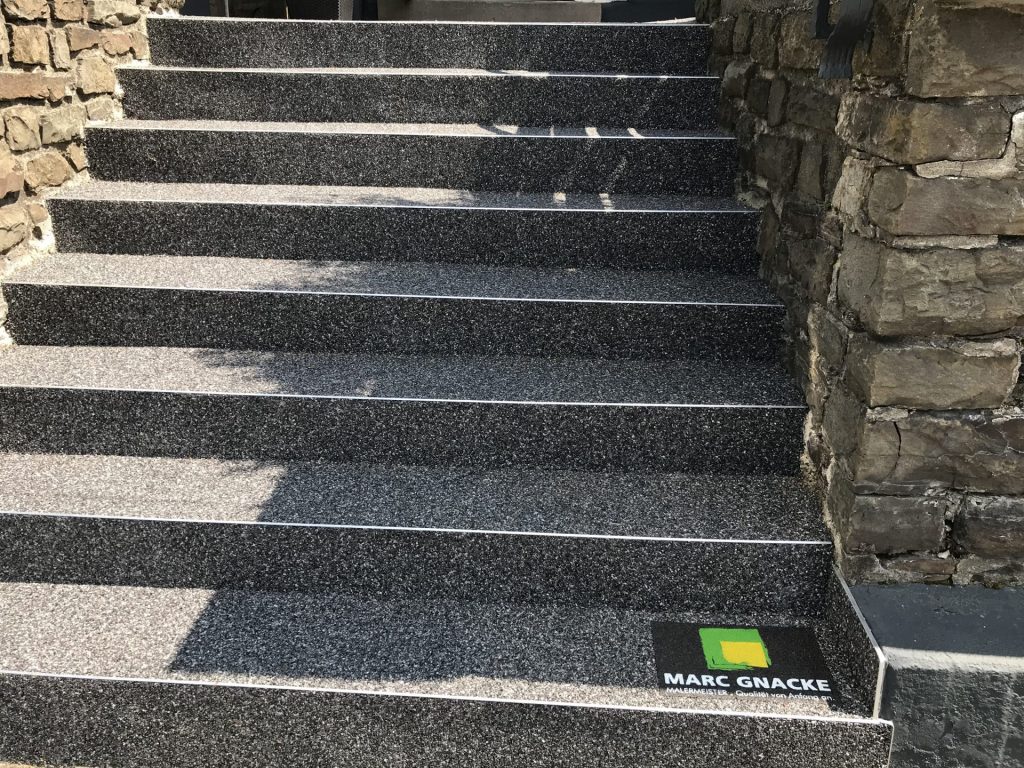
Anyone who has ever renovated their own home knows the feeling of happiness that comes with seeing new wallpaper, fresh colors and perfectly coordinated floors. Whether it’s just replacing the old-fashioned floral pattern and the scratched laminate or implementing the long-planned dream design: In the end, it’s all about feeling good about the overall result.
While some of the work can still be done on your own, many people shy away from the work and cost of more extensive projects such as renovating old steps. The result is an uneven overall impression and the feeling of being “not quite finished”.
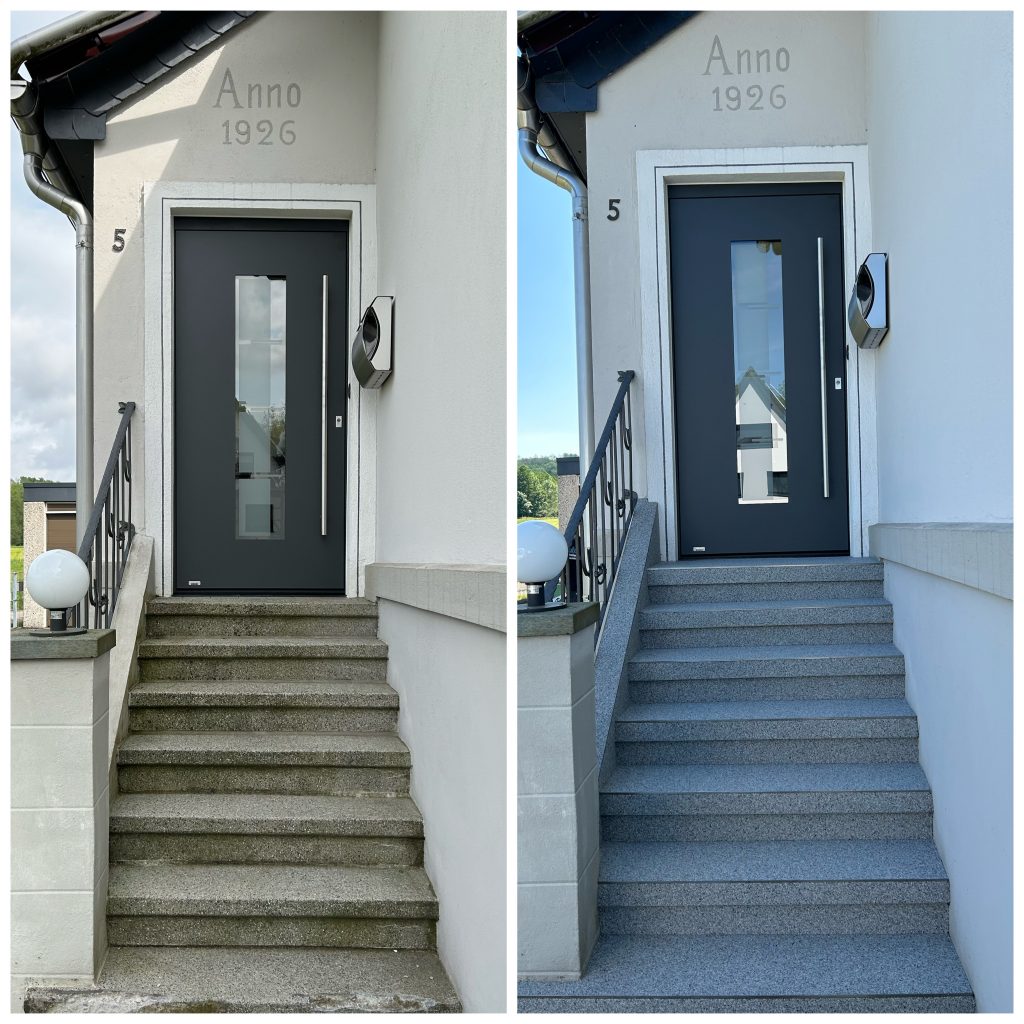
Stone carpet stair renovation -
Staircase renovation with stone carpeting indoors and outdoors
The reason for refurbishment is always a serious defect. Refurbishment should be carried out if, for example, damage to steps needs to be repaired. Refurbishment restores the original quality of the staircase. Work such as sealing is usually very time-consuming and requires specialist knowledge and experience. It should therefore be carried out by a specialist company.
Refurbishing stairs with stone carpet is a tried and tested method of making heavily used stairs functional and aesthetically pleasing again. Renovation with stone carpet allows worn and damaged steps to be renewed without the need for costly demolition work. This process involves thorough preparation of the object to ensure an even substrate structure. The stone carpet is then applied and forms a resistant surface.
Choosing the right colors and textures makes it possible to integrate the steps harmoniously into the overall look of the room. In addition to the aesthetic improvement, gravel coating also offers practical benefits such as easy cleaning and increased durability. Refurbishment can therefore extend the life of the structure while enhancing the aesthetics of the space.
Renovating stairs with stone carpet
Make your steps modern and slip-resistant
Renovating with marble or quartz gravel is a creative and practical way to bring technically or visually outdated staircases up to date. The gravel coating not only provides a hard-wearing surface, but can also help to freshen up rooms. When renovating, it is important to carefully check the current condition of the steps. If there are purely visual defects, nothing stands in the way of renovation.
Once the substrate has been determined to be stable, the stone granulate is applied to the steps and forms a seamless, non-slip surface once it has hardened. This not only gives the steps an aesthetic upgrade, but also improves safety, as the non-slip surface reduces the risk of tripping. The variety of colors and grain sizes available makes it possible to match the gravel coating to the style of the room. This turns a simple staircase into an impressive design element that increases living comfort and the value of the property.
Visually enhance wooden stairs with stone carpeting
Laying stone carpet on wooden stairs
What many builders don’t know is that old wooden and concrete steps can be renovated quickly and easily without having to replace them straight away. Stone carpet can be adapted extremely flexibly to different substrates. Stairs can be renovated without any chiselling or demolition work. When renovating with stone carpet, you get steps with a new design without having to invest in a completely new staircase.
Gravel coating is an attractive option, especially for wooden stairs, to get rid of worn steps and creaking floorboards. Existing unevenness is simply evened out during installation. The result is a non-slip surface with a high level of slip resistance.
Our consultants will be happy to provide you with expert advice on your staircase renovation.
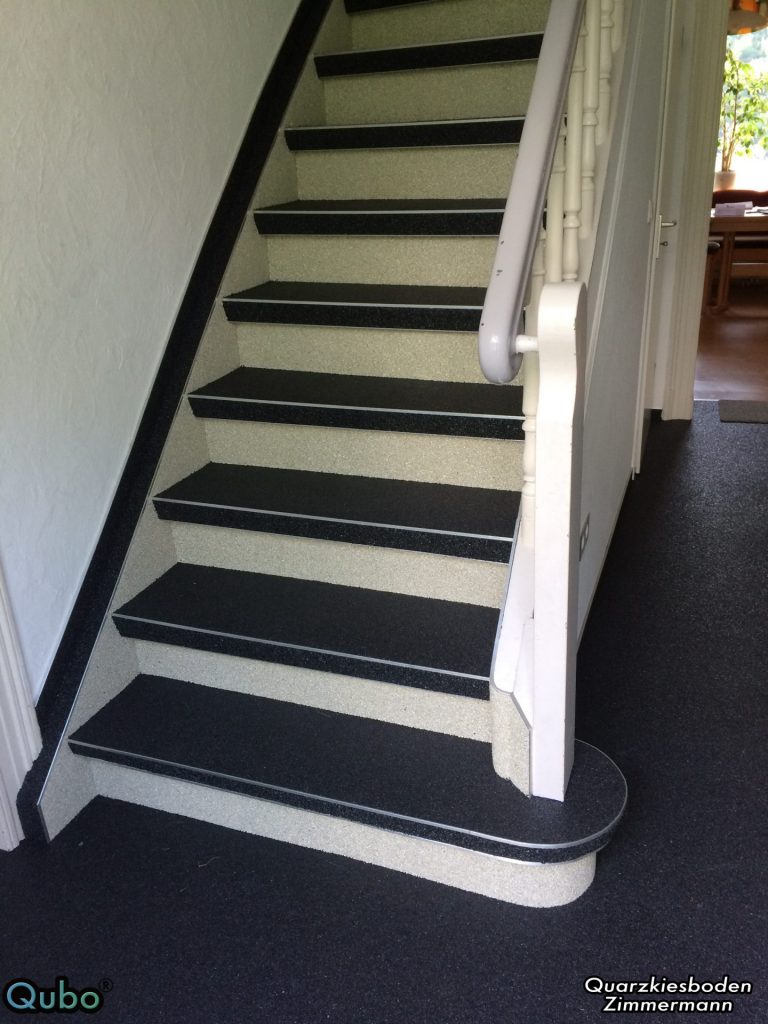
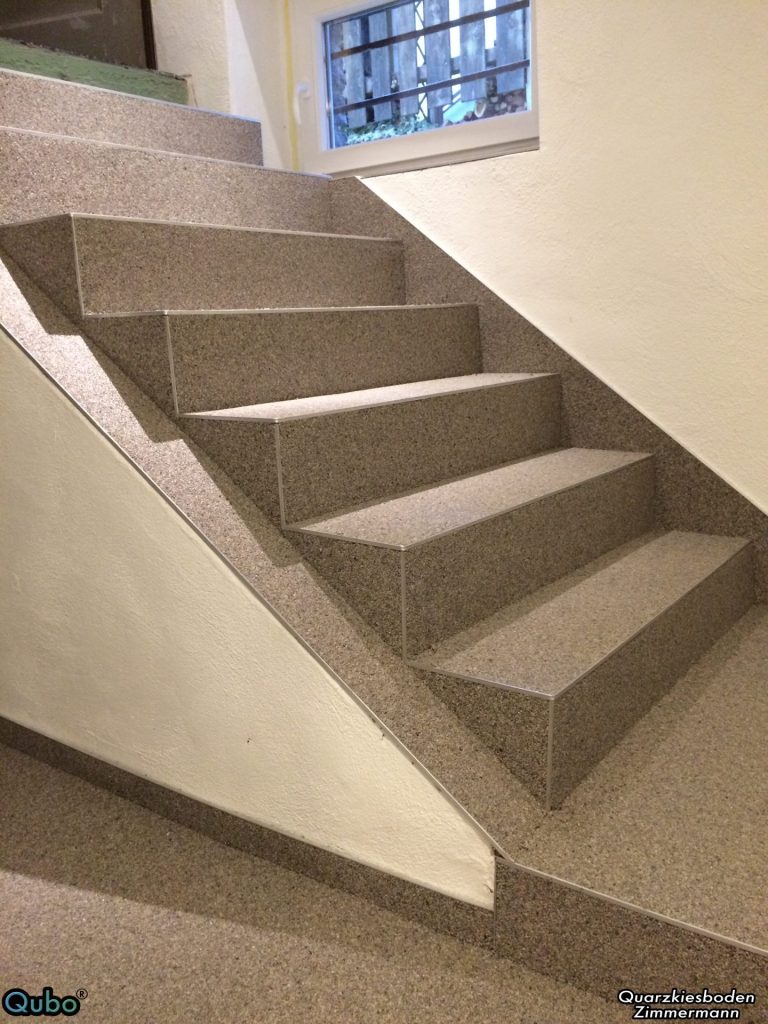
From the basement to the attic - these are the advantages of stone carpet stairs
Quick renovation with Qubo® stone carpet
- the high abrasion resistance
- high flexibility with regard to the substrate (concrete, tiles, wood, screed…)
- the seamless surface
- the huge selection of colors
- light resistance outdoors, in conservatories and in rooms with high levels of sunlight
- the anti-slip effect
- the high drainage capacity due to the open-pored structure
- the quick-drying surface in wind and sun
- 100% frost protection
When renovating a staircase with marble or quartz gravel, there are also some special properties:
- Any step form can be adopted
- The joints – also known as risers – can be purchased as single or double joints
- Skirting boards and side strips can also be created from marble and quartz gravel, so there are virtually no limits to your own design ideas
- No need for demolition work and tedious preparatory work such as sanding or chiselling
- Old railings can – if desired – be retained, as any brackets can be reworked
- Depending on the type of staircase and the type of coating, the renovation takes 3-5 days
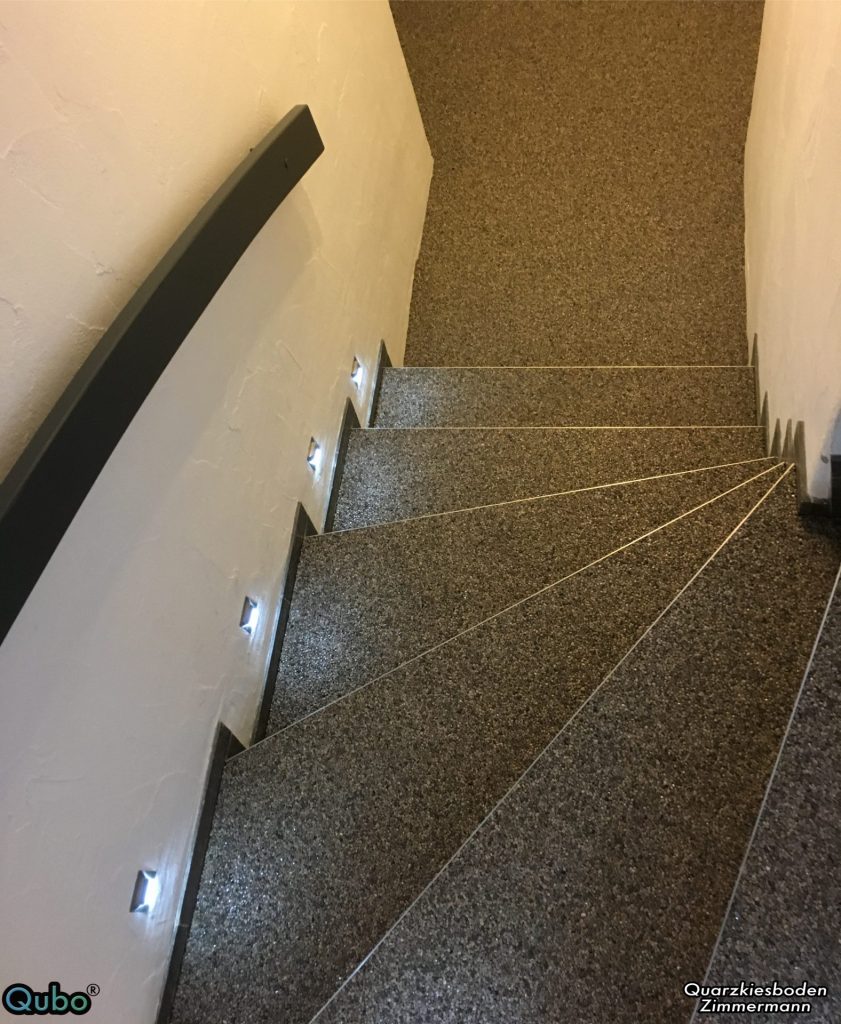
Renovating stairs with stone carpet in 6 simple steps
How do old staircases become new stone carpet stairs?
Before the actual renovation, there is precise planning and detailed consultation with an expert installer. This is where the individual construction steps for creating the stone carpet staircase are discussed, deadlines are agreed and design decisions are made. With the latter point in particular, it is important to have a precise idea of the future stone carpet staircase so that the finished object fits in well with your own living environment. Thanks to the large selection of gravel colors and the possibility of combining and mixing several shades, the gravel coating can be easily integrated into any existing or planned designs and colors.
Ask for samples of the possible gravel colors to help you choose the right color. Installers of Qubo® stone carpet
usually carry a sample case with 100 color samples, which makes the decision much easier.
Step 1 - Substrate preparation
As soon as the design of the new stone carpet staircase has been discussed and the appointment agreed, the first step in the staircase renovation process begins: Preparing the surface for the stone carpet. Depending on the type of staircase, different preparatory work may be necessary here. For example, loose tiles may need to be removed and dust vacuumed up before the renovation can begin. The new stone carpet stair coating will only last permanently on a clean and stable substrate.
For external staircases, the preparation of the substrate also includes the sealing of the building structure. As a gravel floor is permeable to water, rainwater is drained away via the sealing layer underneath. This must therefore be completely undamaged and watertight. Otherwise, water will penetrate the structure, which can lead to damage in the long term.
All necessary measures are planned by the specialist in a preliminary discussion with you.
Step 2 - Priming the steps
Once the clean, solid substrate has been prepared, the primer is applied. This step is particularly important in order to create an effective bonding bridge between the stone carpet and the substrate. The procedure varies depending on the material of the steps. Depending on the intended use, special primers are used for tiles, for wet or particularly absorbent substrates and for wood. Mesh mats are used on wooden platforms. These are coated with a primer resin so that movements in the wood are absorbed. This not only ensures that the gravel floor lasts longer, but also effectively combats the creaking of old wooden floors.
For outdoor stone carpet stairs, a further step is necessary after priming: The application of a sealing layer. The sealants we recommend also serve as a bonding bridge for the subsequent gravel coating. Here too, the laying professional will advise you on the necessary work steps.
Step 3 - Railing the steps
The next step is to rail the steps. This step is necessary to give the steps their contour: Profiles just a few millimetres high are laid along all the necessary edges to create closed surfaces for the new coating. This applies to the treads as well as the risers and wall connections.
Depending on the type of construction, railing can be completed in a short time or take many hours. The latter is particularly the case for stairs with double joints and open banisters, where more than one joint edge is splinted and coated.
The profiles used are made of aluminum or stainless steel, depending on the area of application, and are adapted by hand. In general, Stone carpet staircases are completely handcrafted construction objects with character.
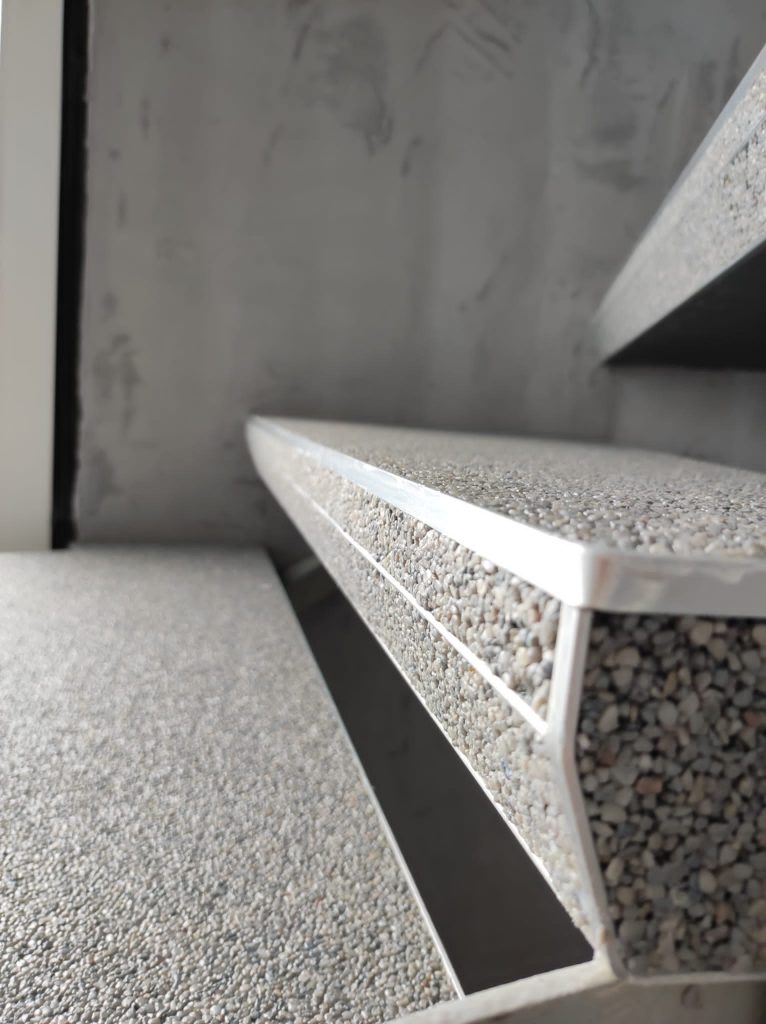
Step 4 - Laying the stone carpet
Stone carpeting consists of quartz or marble gravel and a binder such as epoxy resin or polyurethane. Polyurethane – PU for short – as a binder is characterized by its UV resistance. PU is therefore not only the ideal choice for outdoor staircases, but also for surfaces in conservatories and for sunlit stairwells.
Mixing gravel and binder produces a cement-like filler. This is applied to the floor with a so-called trowel and can be easily adapted to all conditions. It is also possible to mix several of the over 100 different colors
to create a completely individual result. Depending on whether only the steps or also the joints and side surfaces are to be renovated with gravel, one type of surface is now processed per work step: First the treads, then the joints and finally the side strips. There are drying phases of one day each between the work steps.
Depending on the area of application, the staircase can now be used again. The resulting open-pored surface is easy to clean, as dust settles in the stone structure. This is quickly and easily vacuumed up with a vacuum cleaner.
If the renovated staircase is exposed to coarse dirt, the surface should be sealed with a pore sealant.
Step 5 - Apply pore closure
For hygienic reasons, frequently used stone carpet stairs in office buildings or apartment blocks should be provided with a pore filler. The pore filler, which still has a slightly bluish sheen when applied, becomes completely transparent after drying. It creates a surface that is particularly easy to wipe with a damp cloth to remove dried-on street dirt, for example.
Step 6 - Apply sealant
For stairs with particularly high loads or surfaces with a Qubo® Painting motif, the final step is to seal the surface with a protective seal. There are various seals for stone carpet stairs to choose from, which create a dirt-repellent layer that even aggressive liquids can no longer harm. It is best to seek advice on this topic during the planning phase.
How long does it take to renovate a stone carpet staircase?
from "quick & easy" to "all-encompassing" - the duration of the staircase renovation depends on this
How long it takes to renovate or create a stone carpeted staircase depends on various factors. First of all, it should be clarified in advance whether risers, wall connections, landings or other features should also be recoated. Then it depends on the shape of the stairs and the desired surface finish. As a rule, 4-5 days must be allowed for the renovation of an old wooden staircase including pore sealing. Likewise, 4 days must be allowed for the coating of concrete steps. If only the treads are to be refurbished, completion is possible within one day.
How much does it cost to renovate a stone carpet staircase?
What factors influence the cost of your stone carpet staircase?
Just like the duration of the renovation, the costs also depend on many factors:
- Staircase location: As a rule, indoor staircases do not need to be sealed, unlike outdoor staircases.
- Number of steps: Staircases with a large number of even steps are proportionally more favorable than entrances with two or three decorative rounded steps, for example.
- Number of landings: Staircases with uniform steps and landings on the half-floors are less complex to coat than spiral staircases, where the steps have individual and complicated shapes.
- Number of work steps: Additional services such as sealing bring their respective advantages, but also require additional journeys, as there is a day’s drying time between the work steps.
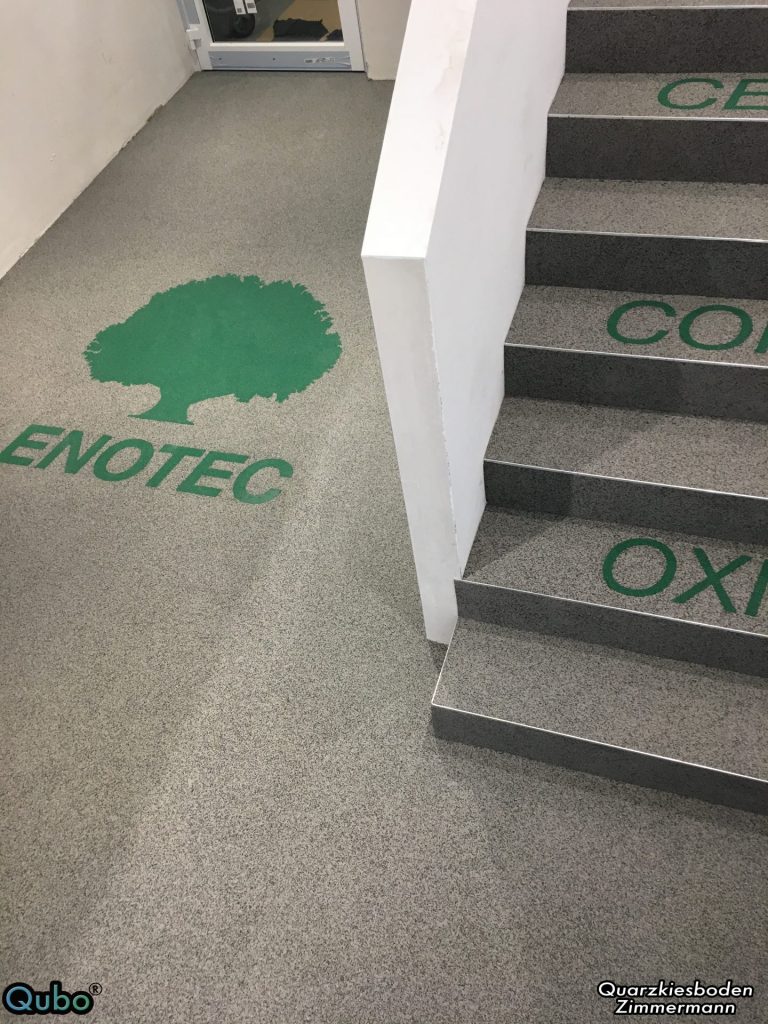
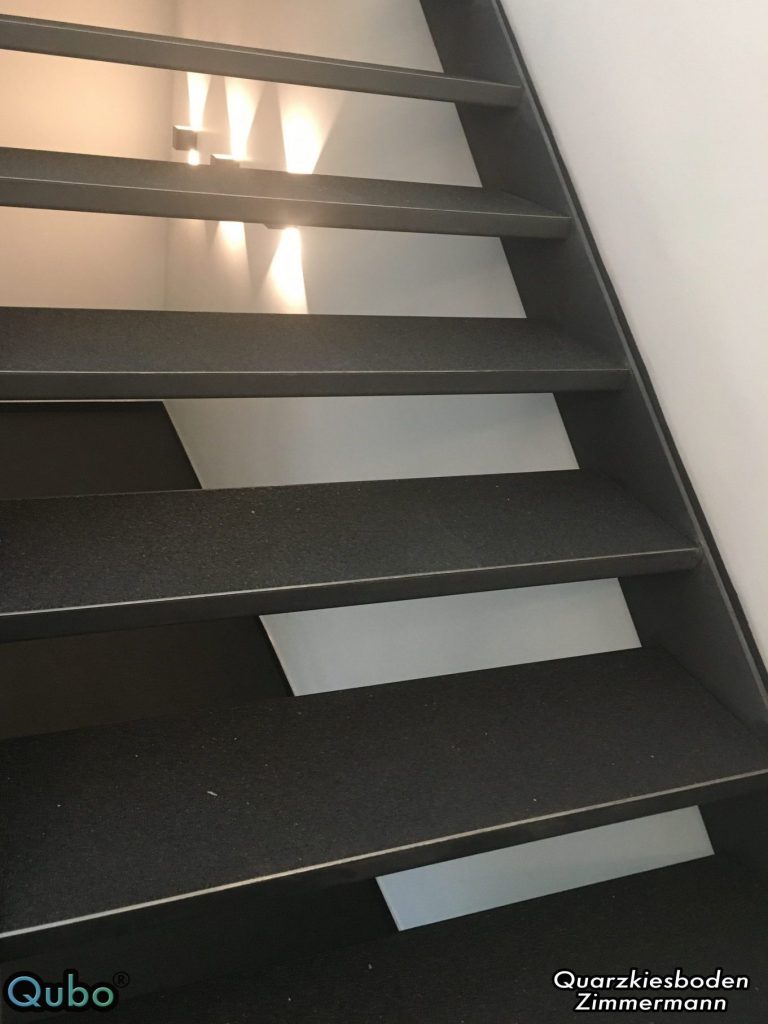
For this reason, it is not possible to determine a fixed price for the renovation of a staircase. You can request a cost estimate on the product pages of Quarzkiesboden Zimmermann at. Here you also have the opportunity to provide precise details about your staircase.
Find a publisher now
To find an installer in your area who can create a stone carpet staircase for you, take a look at the overview of the Qubo® bases. In addition to our certified support points, many other trained craftsmen work with our Qubo® material. We will put your request through to the right company. So together we can ensure that your staircase…
…for a strong appearance!
Non-binding cost estimate and advice
Link collection
- sz art of airbrush – Our partner for Qubo® Painting stone carpet logos
- Overview of Qubo® support points – Your professional contacts for stone carpet stairs and more
- Product pages
- Worth knowing
- Qubo® Painting
- Easy to clean and maintain gravel floors
- Redesigning rooms in the interior
- External surfaces seamless and non-slip
- Primers for gravel floors
- Binder
- Sealing and pore closure
- Gravel colors
- Redesign conservatories
- Costs for your new gravel floor
- Coat the entrance area with marble or quartz gravel
- Seamless bathroom design
- Gravel floors – ideal for dogs
- Frost-proof coating for terraces
- Renovating balconies without joints
- Gravel coating as a pool surround
- Quartz floors made from colored quartz
- Seamless kitchen design
Renovating old indoor and outdoor stairs is effortless with marble and quartz gravel. By using a gravel coating for your stairs, you can achieve a fresh design without the need for a completely new installation. It also reduces disturbing noises. Stone carpet stairs are of course also particularly suitable for use in entrance areas.
Yes. After the gravel layer has been applied, a stone carpet staircase already has a slip resistance class of R10. By applying special sealants, this slip resistance class can be increased to R11 or even R12.
The renovation of a stone carpet staircase usually takes approx. 3-5 days.
A stone carpet stair covering can be cleaned with a vacuum cleaner or a damp mop. Use the Qubo® stone carpet cleaner for this purpose.
In most cases, colored quartz or marble gravel is used for the production of stone carpets. However, there are considerable differences in quality here, for example in the proportion of dust in the material or the types of marble used.
Mica additives and various precious and semi-precious stones can be added, but this is another cost factor.
First and foremost, the area of application determines the pricing. However, the costs depend on many different factors, including
- the type of binder required
-
from the primer
-
the choice of skirting boards, for example if these are also made of quartz gravel
-
from the labor costs of the professional installer
-
the size of the area to be laid
Colored quartz is available in the following grain sizes:
-
1–2 mm
-
2–3 mm
- 3–4 mm
Marble gravel is available in the following grain sizes:
-
1–4 mm
-
4–8 mm
- 8–15 mm
Of course, the choice of gravel grain size has an effect on the laying thickness of the gravel floor.
The laying thickness depends on the gravel grain size and the area of application. Normal quartz gravel with a grain size of 2 – 3 mm can be laid indoors with a thickness of 6 mm.
An installation thickness of 8 mm is used outdoors and on stone carpet stairs indoors due to the load.
Finally, 10 mm of material is applied to external stairs.
Vertical surfaces such as the risers of stone carpet stairs, skirting boards and walls are always laid in 6 mm.
The larger the grain size of the gravel, the higher the installation height of the floor covering. This means that more gravel and additional binder is required per m². The price increases accordingly.
The primer forms the bonding bridge between the building structure and the gravel floor. The material can be applied to almost any substrate, for example tiles, wood, stone, concrete and metal. Different substrates require different preparation steps.
On tiles and metal, for example, a primer is required to give the smooth surface stability during installation.
On porous stone and absorbent screed, the appropriate primer must be used to prevent the binder from being absorbed, which is intended to ensure that the pebbles remain in place.
To coat wooden planks with a gravel floor, the movement of the planks against each other must first be stopped. To do this, the installer first applies a mesh mat to the wooden floor. Once the filler has dried, the gravel floor is applied.
In kitchens and bathrooms in particular, the stone carpet should be fitted with a pore seal for reasons of hygiene. It prevents leaked, sticky liquids from penetrating the gravel floor. While penetrating liquids are difficult to remove from an open floor, the pore closure allows effortless cleaning by wet mopping.
Dogs, cats and the like feel much more comfortable on the textured surface than on smooth floor coverings such as tiles or laminate, as they do not slip on stone carpets. This ensures a safe feeling for four-legged friends, especially when walking on stone-carpeted stairs.
However, it is advisable to apply a pore sealant to the floor to ensure an easily wipeable surface.
Definitely, yes! A stone carpet on your
Yes, stone carpets are well suited for outdoor use as they are weather-resistant. They are resistant to UV radiation, frost and moisture.
Our Qubo® quartz gravel can be used outdoors without any problems. Their special coating gives the quartz pebbles additional protection from sunlight.
Our marble pebbles, which are also suitable for outdoor use, come from Italian quarries and are naturally lightfast.
-
High drainage capacity due to open-pored structure
-
Quick drying in sun and wind
-
Easy to clean and self-cleaning
-
100% frostsicher
-
UV-stabil
- Gentle, massage-like walking comfort when walking barefoot
The most important thing when laying gravel floors in outdoor areas is preparing the substrate. This ensures the durability of the finished floor.
On the one hand, this is because a primed subfloor provides significantly increased adhesion for the filled gravel. On the other hand, a sealing layer keeps rainwater away from the building structure, for example, which supports long-term durability.
Options for sealing building structures are
- Sealing using an epoxy resin seal with sealing membrane
- Sealing using a flex sealing slurry
In order to drain rainwater effectively, the floor covering is laid with a gradient of at least 1.5%.
No, in outdoor areas, the stone carpet is always laid as an open system to ensure drainage capacity and thus the drainage of rainwater. This makes them 100% frost-proof and therefore ideal as pool surrounds and as a covering for balconies, terraces, entrance areas, outdoor steps and loggias.
We would like to point out that we do not recommend stone carpets in the direct shower area. The reasons for this can be found in the basic structure of the floor and the wet room. Just as the tile adhesive under a tile does not form a completely flat surface without air pockets, pores also remain underneath a sealed gravel floor.
If, after years, a silicone seam leaks and water from a fitting, for example, penetrates between the wall or floor covering and the seal of the building structure, the transparent pore seal reacts with the water and forms white stains. As these occur underneath the seal, they cannot be wiped away or removed by drying.
This is why insurance companies do not classify stone carpets as suitable for wet rooms and do not replace such coatings in the event of damage. We therefore recommend microcement coatings for showers. With these, there is no water-bearing layer between the floor covering and the substrate, so there is no risk of moisture penetration. Due to the many customization options for microcement, it can also be combined with a marble or colored quartz floor. Just get in touch with us.
All our gravel floors use natural stones as the base material. This is why many people also refer to stone carpeting as natural stone carpeting.
The gravel is available natural and colored.
FAQ
Details and facts, key figures and explanations – here you will find answers to frequently asked questions about our Qubo® products. If any details remain unclear, simply contact us. We will be happy to advise you personally and promptly.

